The Effect of a Corrosion Inhibitor on the Rehabilitation of Reinforced Concrete Containing Sea Sand and Seawater
Abstract
1. Introduction
2. Materials and Methods
2.1. Materials
2.2. Synthesis of the Imidazoline Inhibitor
2.3. Concrete Specimen
2.4. Bidirectional Electromigration Technology
2.5. Testing Methods of Reinforced Concrete
2.5.1. Corrosion Potential of Rebar
2.5.2. Electrochemical Test
2.5.3. Chloride Ion Concentration in Concrete
2.5.4. Content of Corrosion Inhibitor in Concrete
3. Results and Discussion
3.1. Corrosion Potentialsof Steel Bars with Different Inhibitors
3.2. Chloride Concentration in Concrete
3.3. Amount of Internal Resistance Corrosion Inhibitor in Concrete
3.4. The Influence of Inhibitor on the Corrosion Potentialsof the Steel Bars
3.5. Effects of Inhibitorson the Chloride Extraction
3.6. Influence of Corrosion Inhibitor Concentration on the Surface of a Steel Bar
4. Conclusions
- (1)
- The corrosion potential showed that the imidazoline and triethylenetetramine inhibitor migrated to the steel surface under the application of BIEM, and improved the corrosion potential of the steel bar, and thus, had a protective effect on the steel bar. When the concentration of imidazoline reached 0.5%, the corrosion potential of the steel bars was lower than −250 mV.
- (2)
- After BIEM treatment, the residual chloride ion concentrations in the reinforced concrete specimens decreased along the thickness of the protective layer. When the corrosion inhibitor content was high, the chloride ion concentrations in the samples containing the corrosion inhibitor were higher than those of electrochemical sample. With the addition of corrosion inhibitor, the chloride concentrations in the concrete specimen were obviously higher than those of samples with ECE treatment.
- (3)
- When the inhibitor content was low, the content of corrosion inhibitor in the reinforced concrete specimens decreased along the concrete protective layer initially and then increased. When the inhibitor content was large, the corrosion inhibitor content in the reinforced concrete specimens was protected along the concrete. The tendency of the layer direction increased first, before decreasing due to the limited dissociation of triethylenetetramine in the high-alkali environment, where some undissociated triethylenetetramine accumulated in the center of the concrete specimen.
- (4)
- This study showed the corrosion inhibitor can enhance the durability of the concrete containing sea sand and seawater. If the durability index of concrete becomes seriously degraded, it can continue to be energized to improve the durability of the concrete.
Author Contributions
Funding
Conflicts of Interest
References
- Xiao, J.; Qiang, C.; Nanni, A. Use of sea-sand and seawater in concrete construction: Current status and future opportunities. Constr. Build. Mater. 2017, 155, 1101–1111. [Google Scholar] [CrossRef]
- Dubois, V.; Abriak, N.E.; Zentar, R. The use of marine sediments as a pavement base material. Waste Manag. 2009, 29, 774–782. [Google Scholar] [CrossRef] [PubMed]
- Çağatay, İ.H. Experimental evaluation of buildings damaged in recent earthquakes in Turkey. Eng. Fail. Anal. 2005, 12, 440–452. [Google Scholar]
- Vand, M.M.J.; Van, G.S.F.; Veldkamp, J.G. Aggregate resources in the Netherlands. Neth. J. Geosi. 2005, 84, 379–387. [Google Scholar]
- Limeira, J.; Etxeberria, M.; Agulló, L. Mechanical and durability properties of concrete made with dredged marine sand. Constr. Build. Mater. 2011, 25, 4165–4174. [Google Scholar] [CrossRef]
- Da, B.; Yu, H.F.; Ma, H.Y. Chloride diffusion study of coral concrete in a marine environment. Constr. Build. Mater. 2016, 123, 47–58. [Google Scholar] [CrossRef]
- Yin, H.; Li, Y.; Lv, H.; Quan, G. Durability of sea-sand containing concrete: Effects of chloride ion penetration. Inter. J.Min. Sci. Tech. 2011, 21, 123–127. [Google Scholar]
- Limeira, J.; Agullo, L.; Etxeberria, M. Dredged marine sand in concrete: An experimental section of a harbor pavement. Constr. Build. Mater. 2010, 24, 863–870. [Google Scholar] [CrossRef]
- Yu, H.F.; Da, B.; Ma, H.Y.; Zhu, H.; Yu, Q.; Ye, H.; Jing, X. Durability of concrete structures in tropical atoll environment. Ocean Eng. 2017, 135, 1–10. [Google Scholar] [CrossRef]
- Tatematsu, H.; Sasaki, T. Repair materials system for chloride-induced corrosion of reinforcing bars. Cem. Concr. Compos. 2003, 25, 123–129. [Google Scholar] [CrossRef]
- Hama, A.; Senpo, O.; Akita, R. Influence of nitrite ion and chloride ion on reinforcement corrosion in concrete. Proc. Jpn. Concr. Inst. 2000, 122, 55–60. [Google Scholar]
- Tritthart, J. Transport of a surface-applied corrosion inhibitor in cement paste and concrete. Cem. Concr. Res. 2003, 33, 829–834. [Google Scholar] [CrossRef]
- JTS153-2-2012. Technical Specification for Electrochemical Anticorrosion of Reinforcement Concrete Structures in Harbour and Marine Engineering; Nanjing Hydraulic Research Institute: Nanjing, China, 2012. [Google Scholar]
- Fajardo, G.; Escadeillas, G.; Arliguie, G. Electrochemical chloride extraction (ECE) from steel- reinforced concrete specimens contaminated by “artificial” sea-water. Corros. Sci. 2006, 48, 110. [Google Scholar] [CrossRef]
- Orellan, J.C.; Escadeillas, G.; Arliguie, G. Electrochemical chloride extraction: Efficiency and side effects. Cem. Concr. Res. 2004, 34, 227–234. [Google Scholar] [CrossRef]
- Ihekwaba, N.M.; Hope, B.B.; Hansson, C.M. Structural shape effect on rehabilitation of vertical concrete structures by ECE technique. Cem. Concr. Res. 1996, 26, 165–175. [Google Scholar] [CrossRef]
- Kubo, J.; Sawada, S.; Page, C.L.; Page, M.M. Electrochemical inhibitor injection for control of reinforcement corrosion in carbonated concrete. Mater. Corros. 2015, 59, 107–114. [Google Scholar] [CrossRef]
- Holloway, L.; Nairn, K.; Forsyth, M. Concentration monitoring and performance of a migratory corrosion inhibitor in steel-reinforced concrete. Cem. Concr. Res. 2004, 34, 1435–1440. [Google Scholar] [CrossRef]
- Sánchez, M.; Alonso, C. Accelerated transport of corrosion inhibitors as complementary methodology for electrochemical chlorides extraction method. In Proceedings of the 2nd International Conference on Concrete Repair, Rehabilitation and Retrofitting, Cape Town, South Africa, 24–26 November 2008; Scientific Research Publishing: Wuhan, China, 2008; pp. 289–290. [Google Scholar]
- Xu, C.; Jin, W.L.; Huang, N. Bidirectional electromigration of a corrosion inhibitor in chloride contaminated concrete. Mag. Concr. Res. 2015, 68, 1–12. [Google Scholar] [CrossRef]
- Mao, J.H.; Yu, K.Q.; Xu, Y.D.; Wu, X.X.; Jin, W.L.; Xu, C.; Pan, C.G. Experimental Research on the Distribution of Chloride Ion Migration in Concrete Cover during Electrochemical Chloride Extraction Treatment. Int. J. Electrochem. Sci. 2016, 11, 4076–4083. [Google Scholar] [CrossRef]
- Xu, C.; Jin, W.L.; Wang, H.L. Organic corrosion inhibitor of triethylenetetramine into chloride contamination concrete by eletro-injection method. Constr. Build. Mater. 2016, 115, 602–617. [Google Scholar] [CrossRef]
- Montemor, M.F.; Simões, A.M.P.; Ferreira, M.G.S. Chloride-induced corrosion on reinforcing steel: From the fundamentals to the monitoring techniques. Cem. Concr. Compos. 2003, 25, 491–502. [Google Scholar] [CrossRef]
- Geng, C.; Xu, Y.; Weng, D. A new method to quickly assess the inhibitor efficiency. J. Wuhan Univ. Technol. 2008, 23, 950–954. [Google Scholar] [CrossRef]
- Pan, C.G.; Mao, J.H.; Jin, W.L. Effect of Imidazoline Inhibitor on the Rehabilitation of Reinforced Concrete with Electromigration Method. Materials 2020, 13, 398. [Google Scholar] [CrossRef] [PubMed]
- Leelalerkiet, V.; Kyung, J.W.; Ohtsu, M. Analysis of half-cell potential measurement for corrosion of reinforced concrete. Constr. Build. Mater. 2004, 18, 155–162. [Google Scholar] [CrossRef]
- Şahmaran, M. Effect of flexure induced transverse crack and self-healing on chloride diffusivity of reinforced mortar. J. Mater. Sci. 2007, 42, 9131. [Google Scholar] [CrossRef]
- Song, H.; Ann, K.Y.; Pack, S. Factors influencing chloride transport and chloride threshold level for the prediction of service life of concrete structures. Int. J. Struct. Eng. 2010, 1, 131–144. [Google Scholar] [CrossRef]
- Saremi, M.; Mahallati, E. A study on chloride-induced depassivation of mild steel in simulated concrete pore solution. Cem. Concr. Res. 2002, 32, 1915–1921. [Google Scholar] [CrossRef]
- Sawada, S.; Page, C.L.; Page, M.M. Electrochemical injection of organic corrosion inhibitors into concrete. Corros. Sci. 2005, 47, 2063–2078. [Google Scholar] [CrossRef]
- Tan, Y.S.; Yu, H.F.; Ma, H.Y.; Zhang, Y.; Wu, C. Study on the micro-crack evolution of concrete subjected to stress corrosion and magnesium sulfate. Constr. Build. Mater. 2017, 141, 453–460. [Google Scholar] [CrossRef]
- Nmai, C.K. Multi-functional organic corrosion inhibitor. Cem. Concr. Compos. 2004, 26, 199–207. [Google Scholar] [CrossRef]
- Eydelnant, A.; Miksic, B.; Gelner, L. Migrating corrosion inhibitors for reinforced concrete. J. Con. Chem. 1993, 2, 38–52. [Google Scholar]
- Zhang, J.; Li, Y.; Shi, J.J.; Zuo, L.F.; Wang, D.Q.; Ma, H. Passive films formed on seawater corrosion resistant rebar 00Cr10MoV in simulated concrete pore solutions. J. Chin. Soc. Corr. Proc. 2016, 36, 441–449. [Google Scholar]
- Jiang, J.Y.; Wang, D.Q.; Chu, H.Y.; Ma, H.; Liu, Y. The passive film growth mechanism of new corrosion-resistant steel rebar in simulated concrete pore solution: Nanometer structure and electrochemical study. Materials 2017, 10, 412. [Google Scholar] [CrossRef] [PubMed]
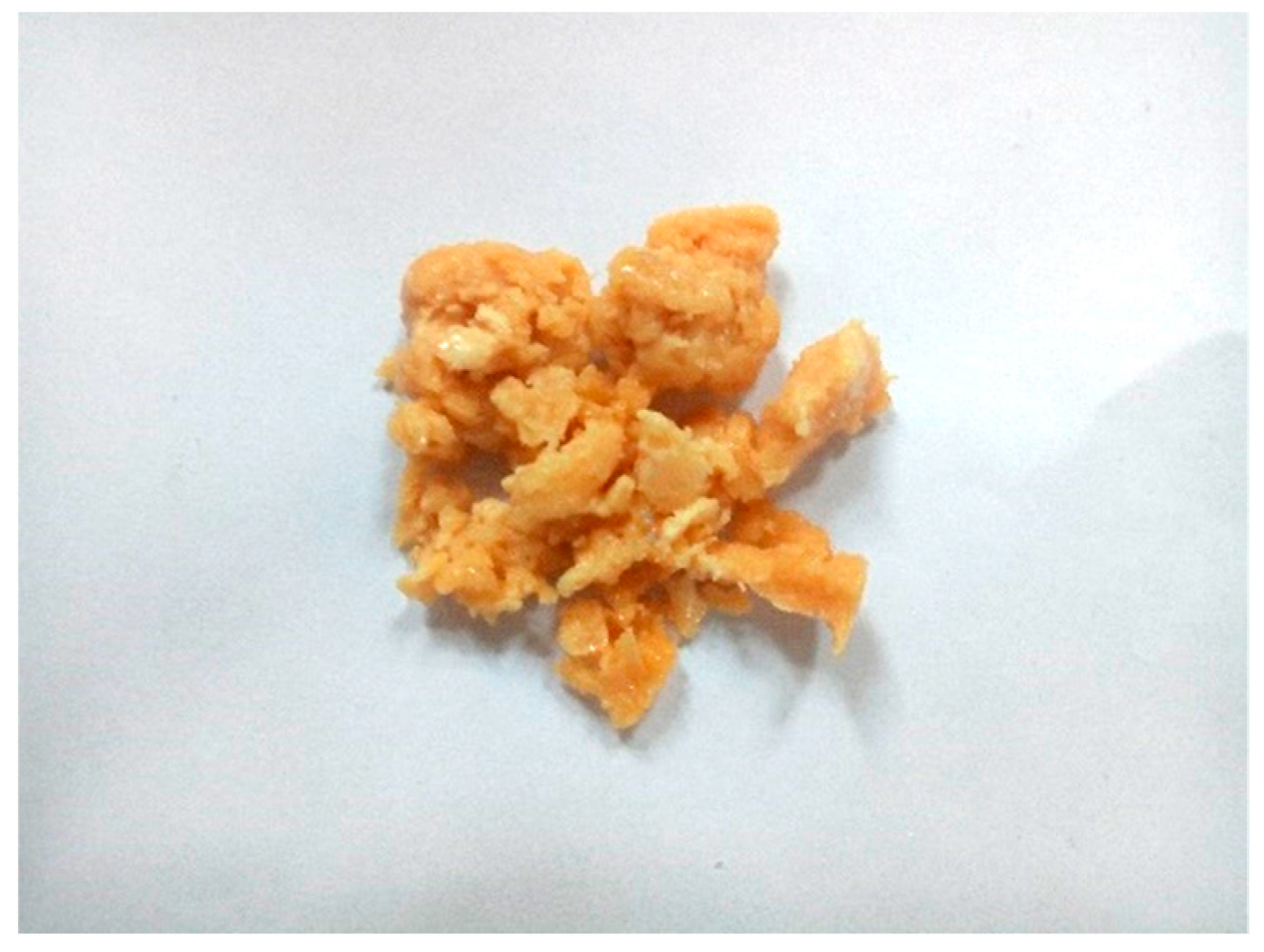
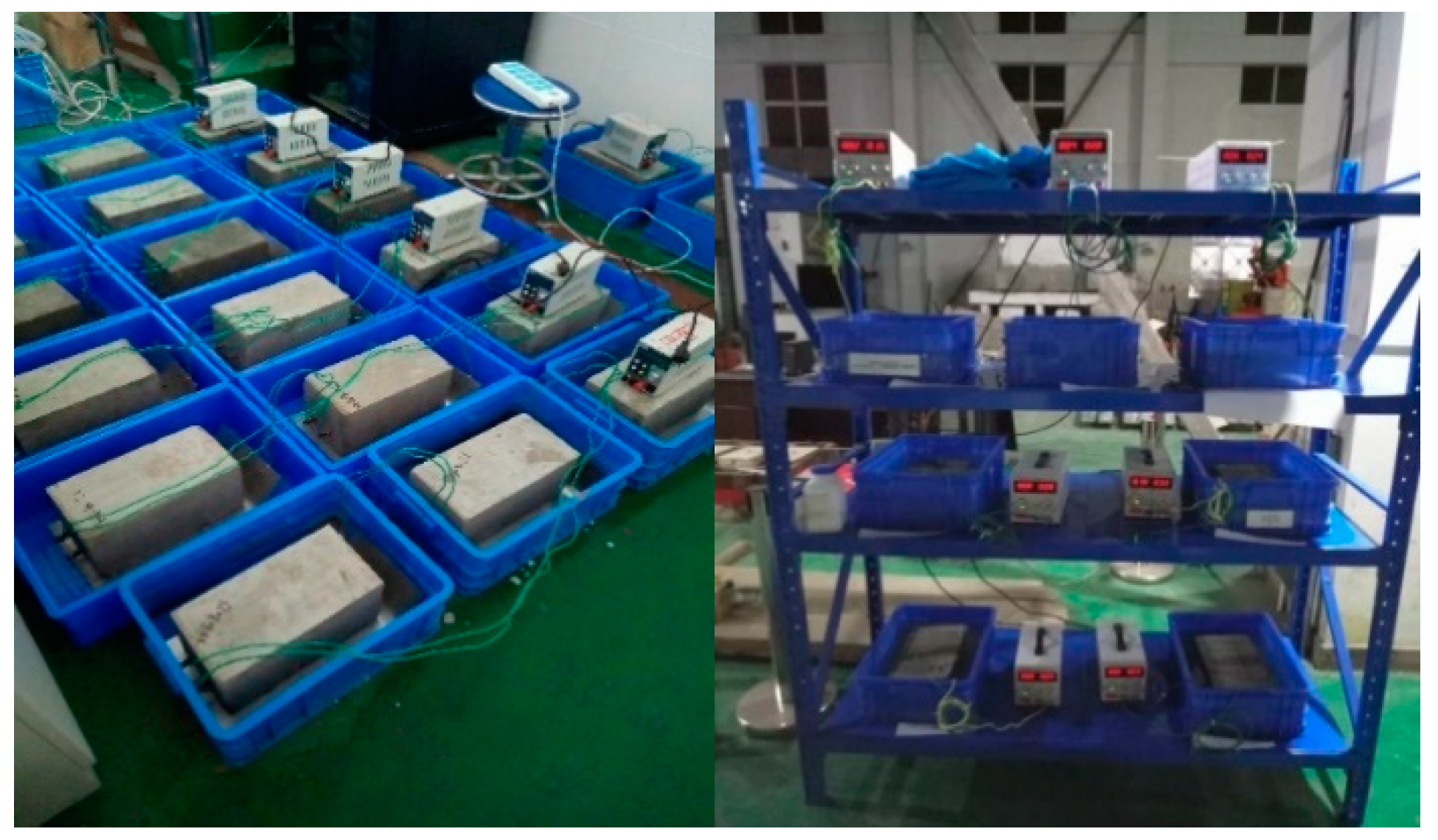
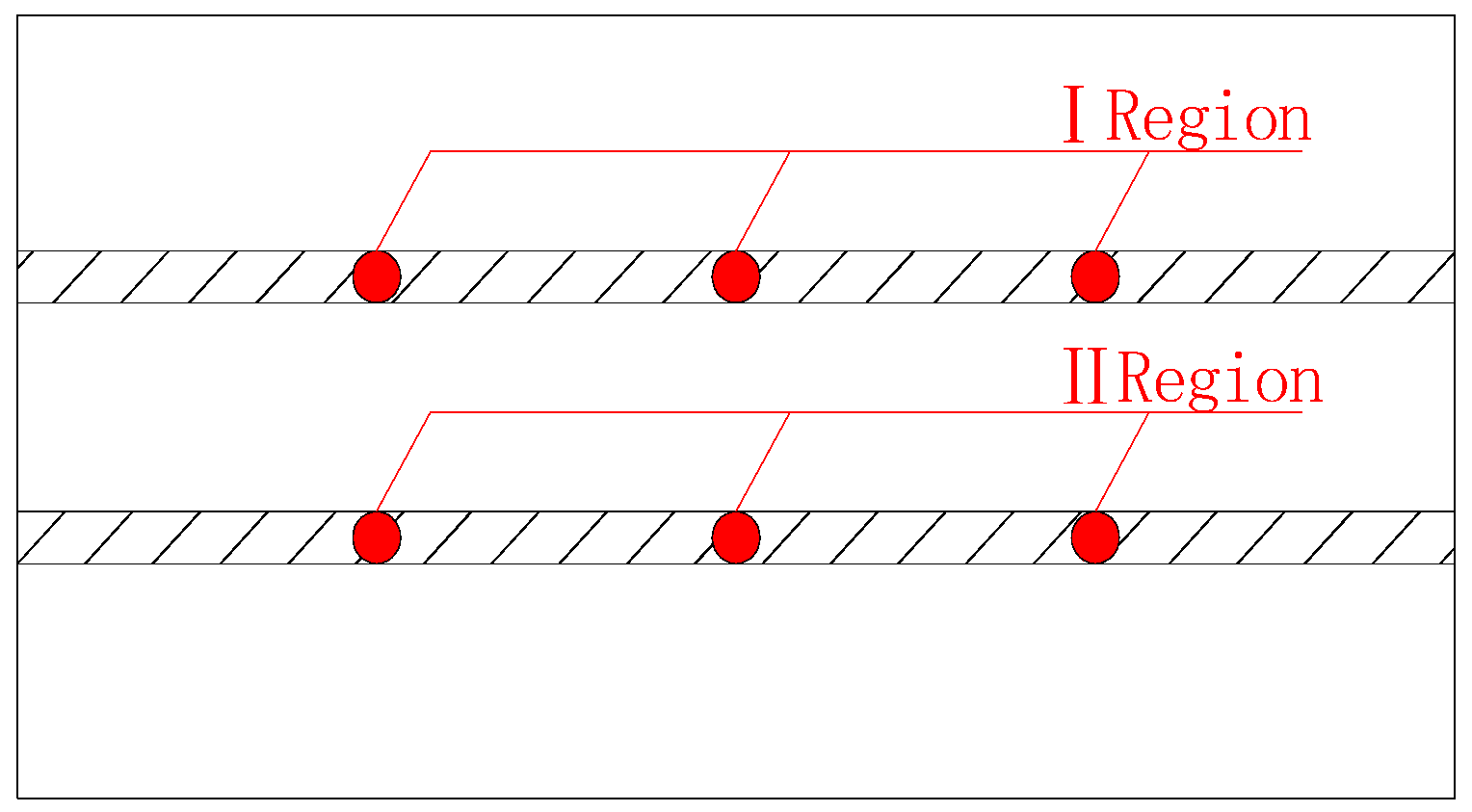
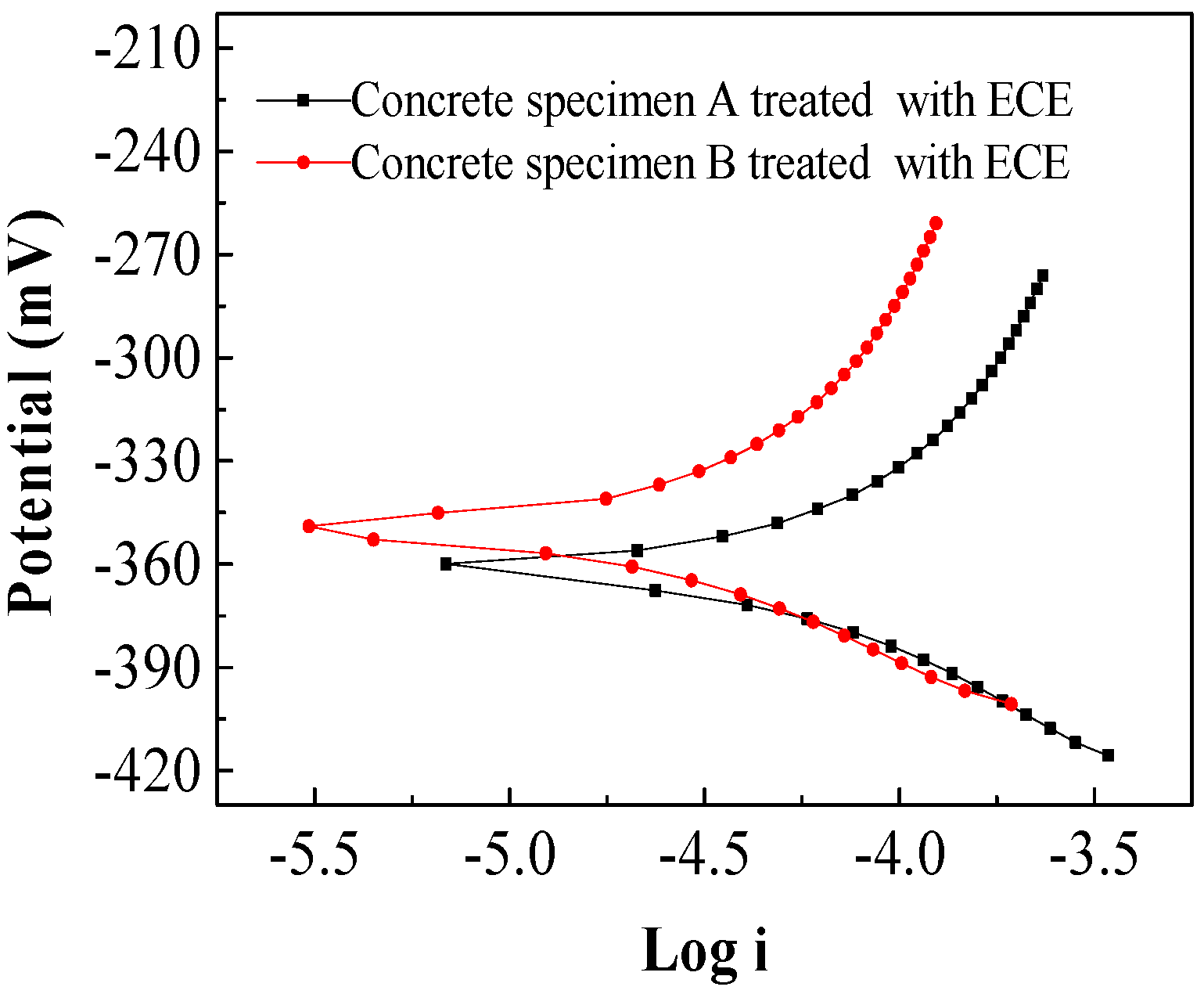
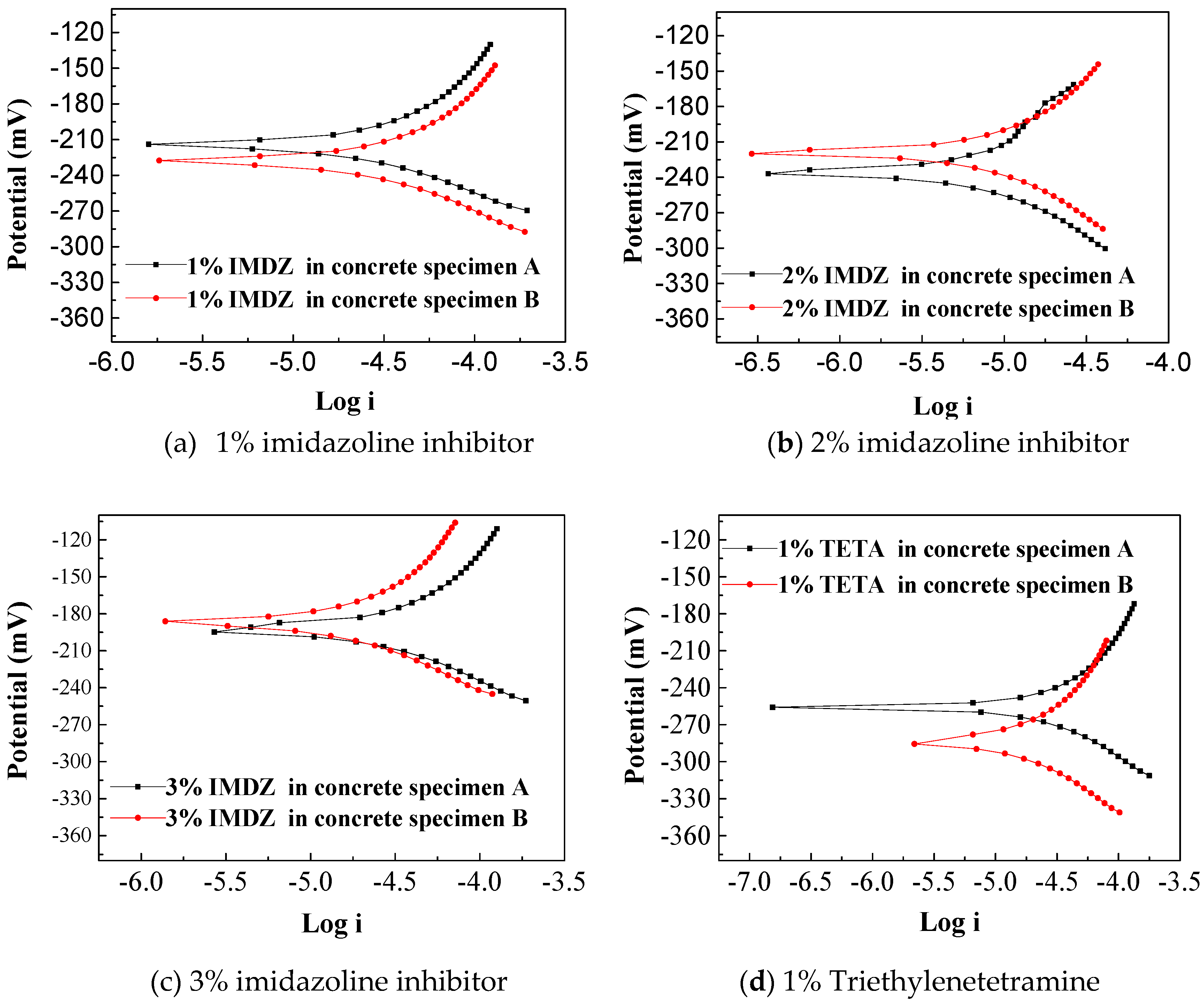
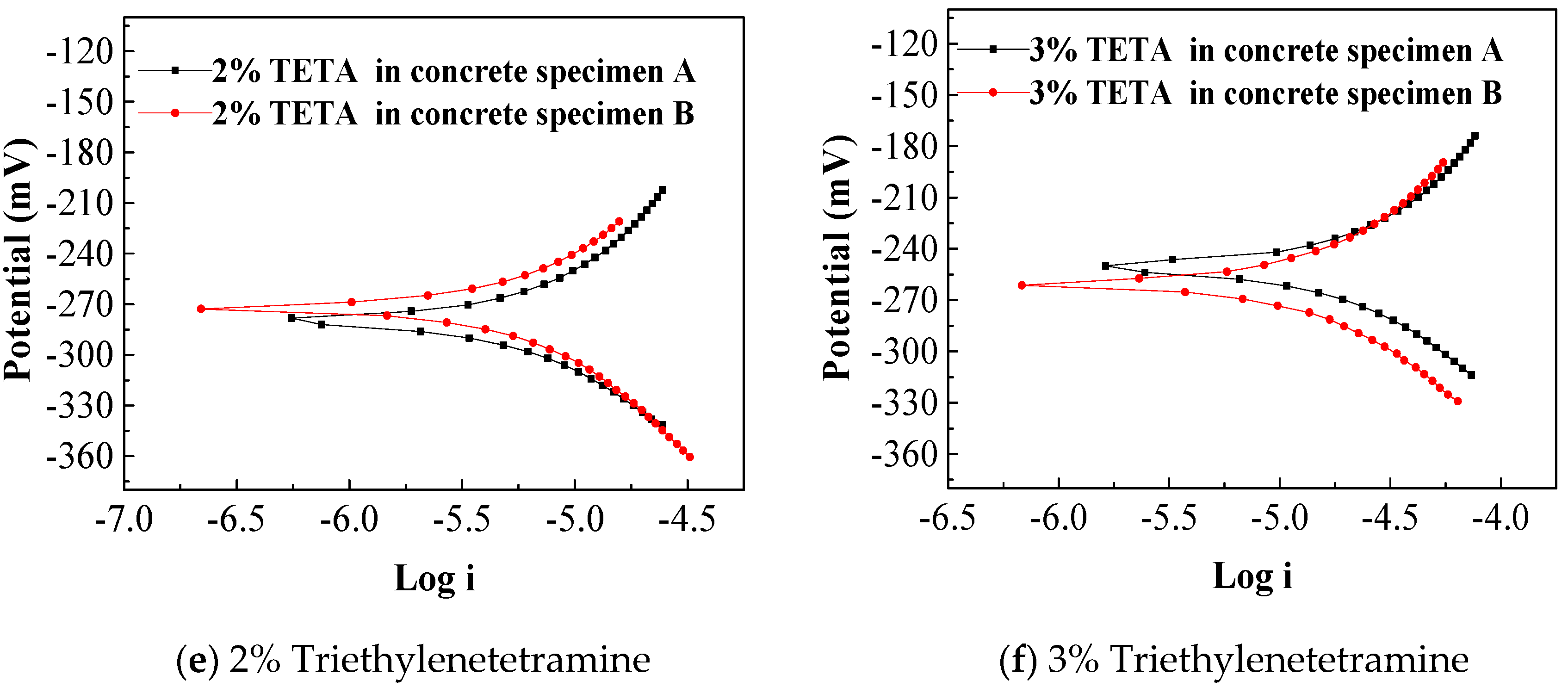
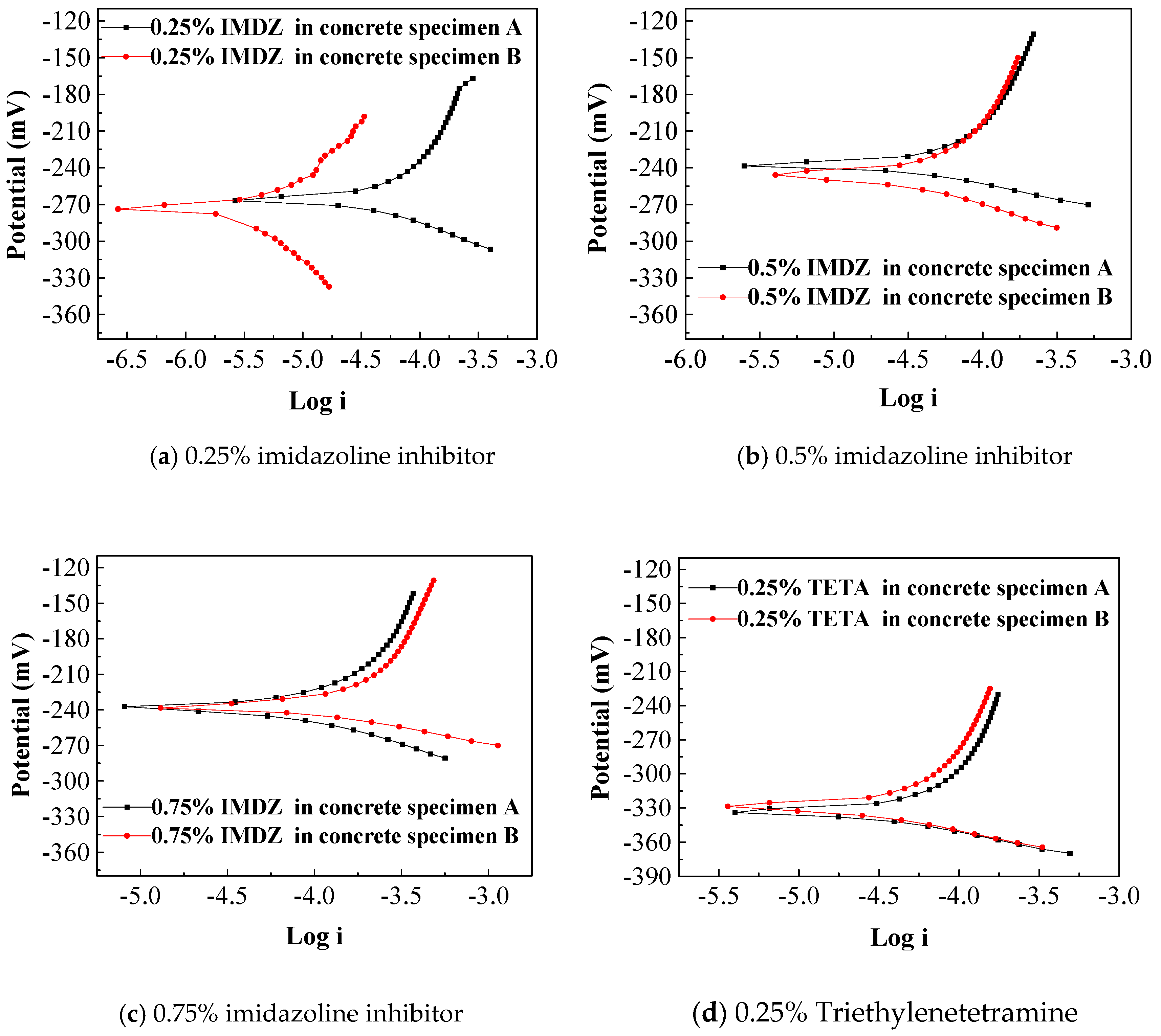
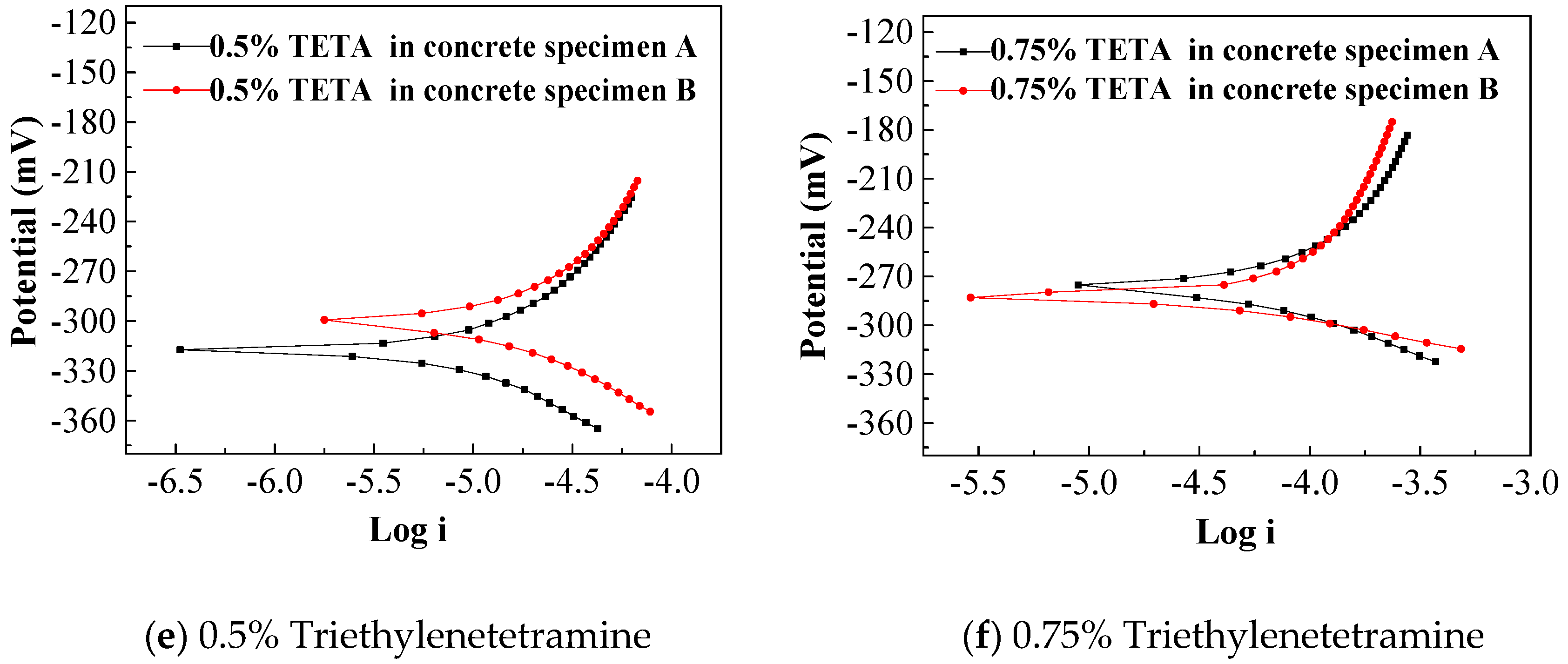
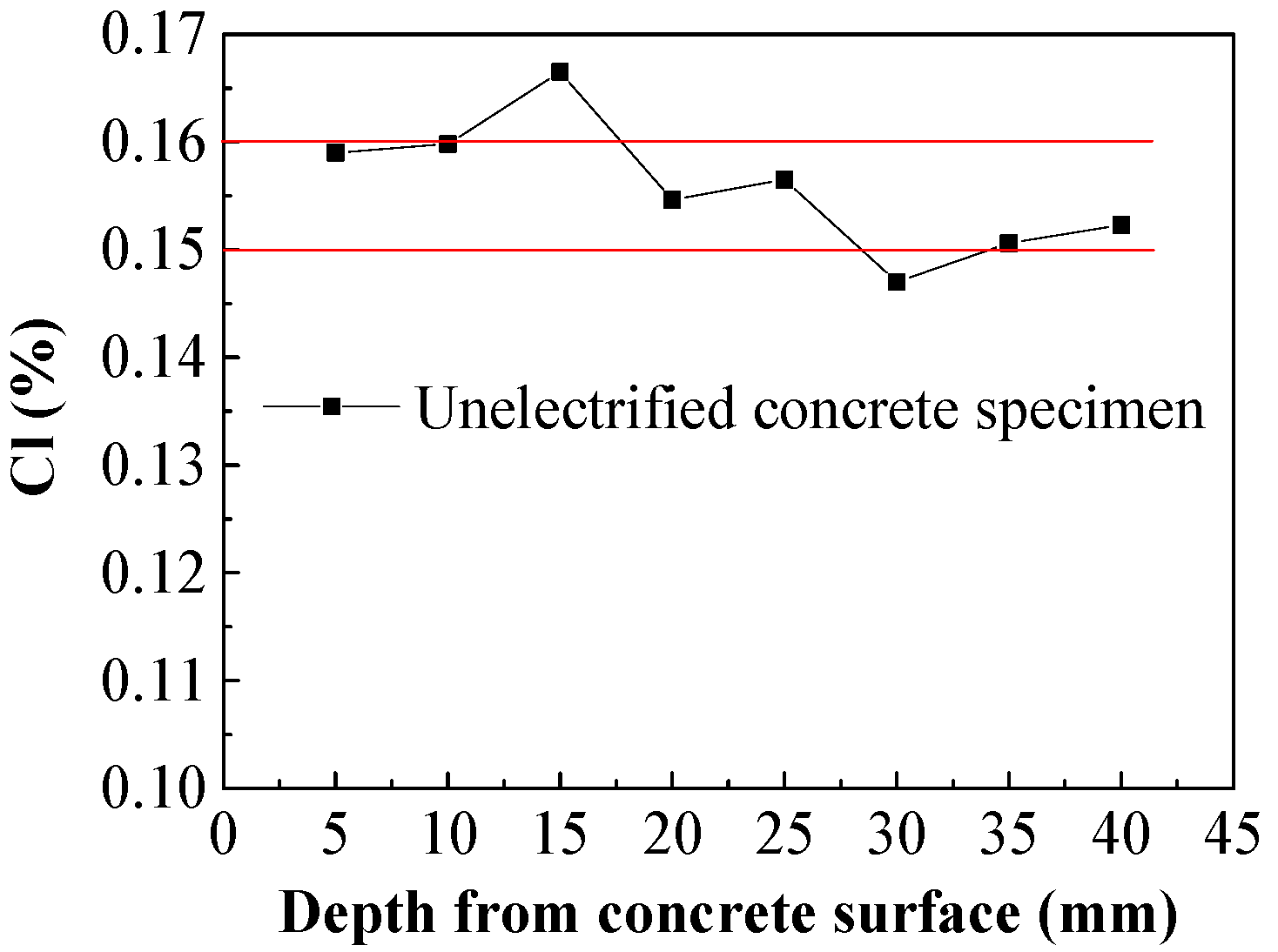
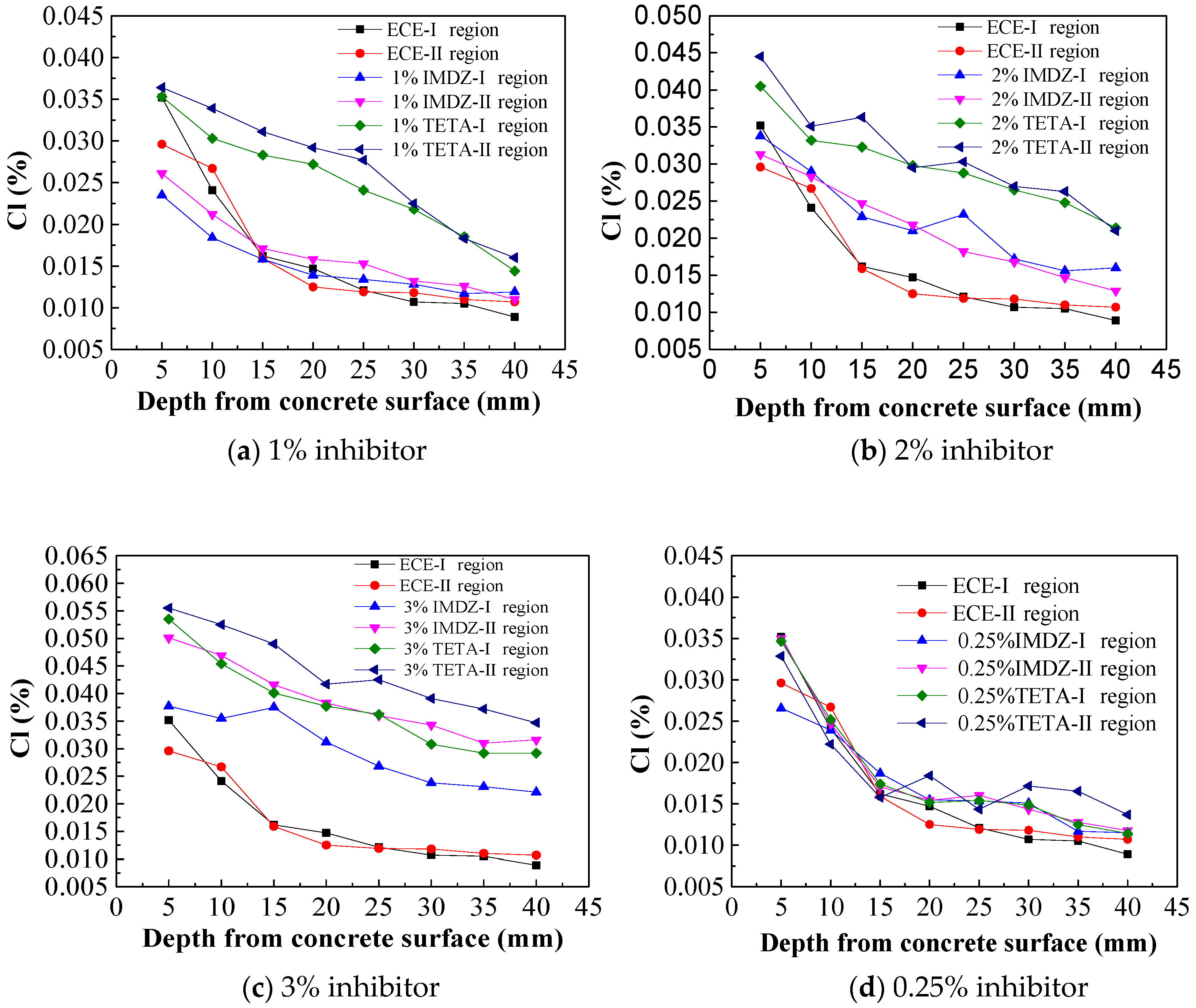

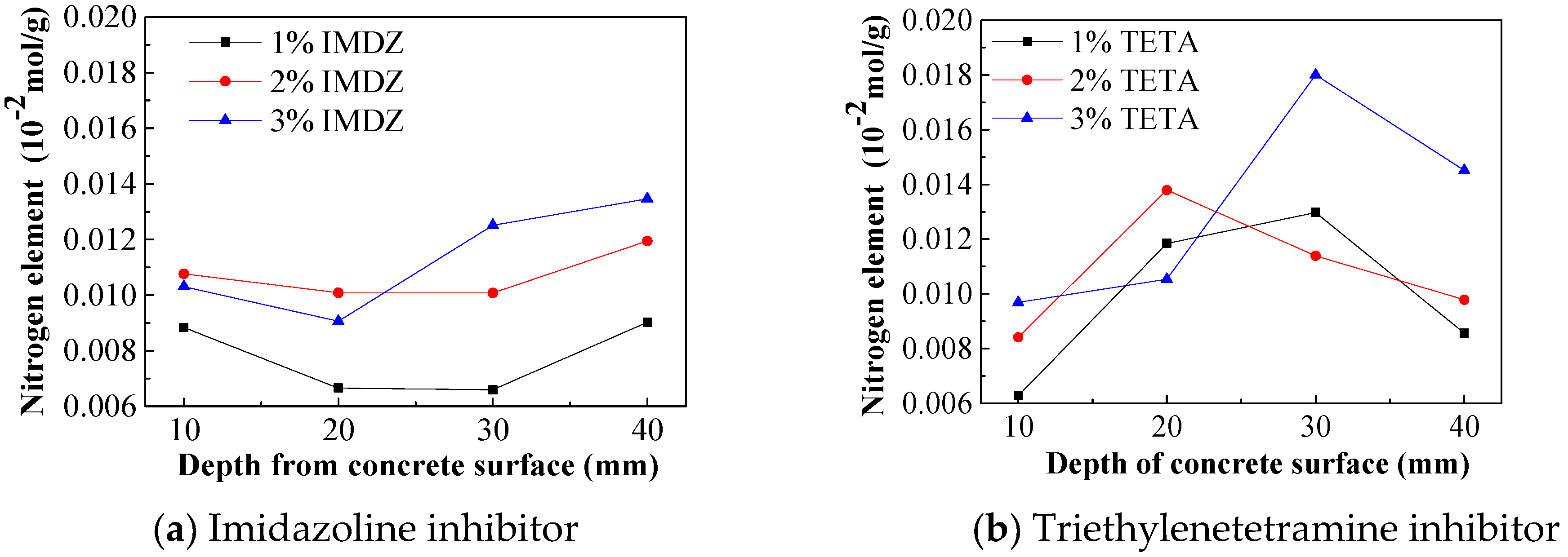
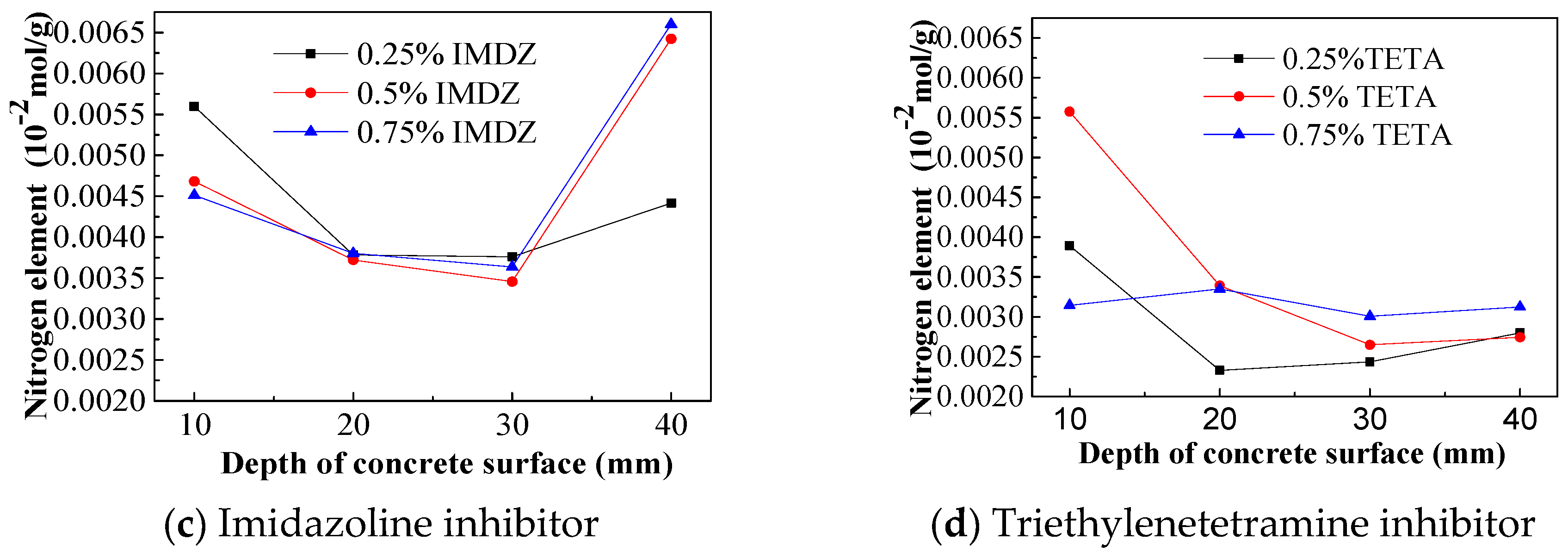
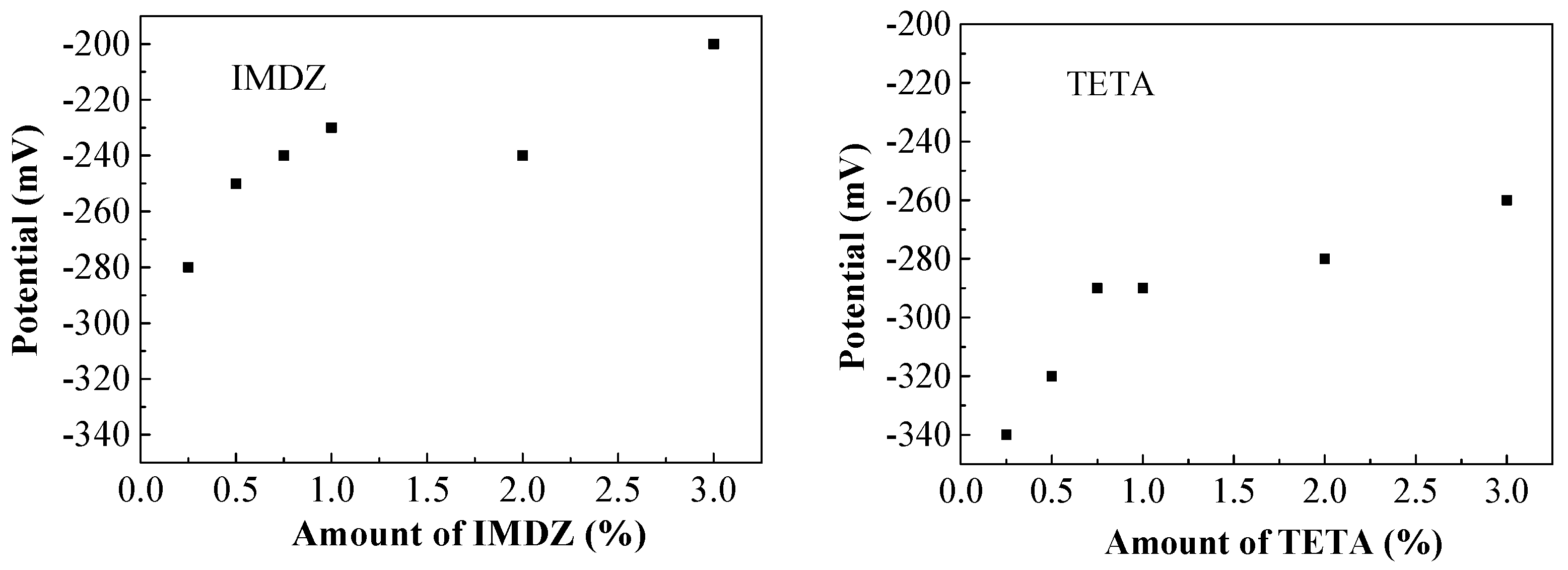
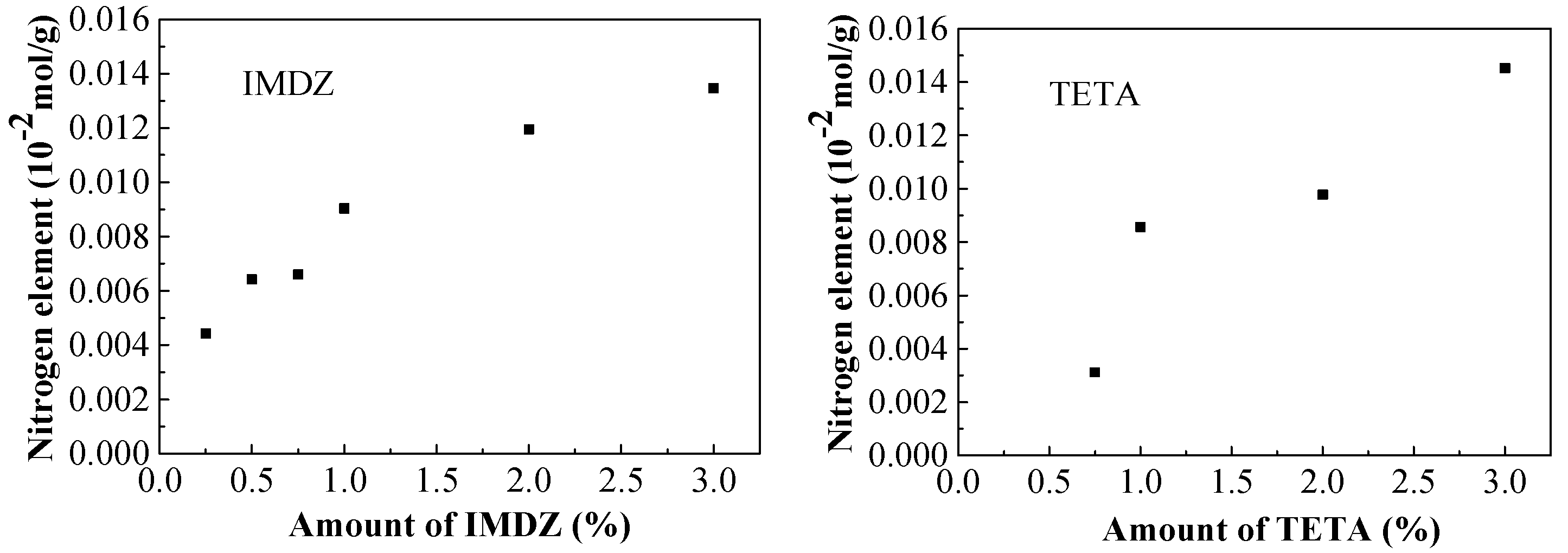
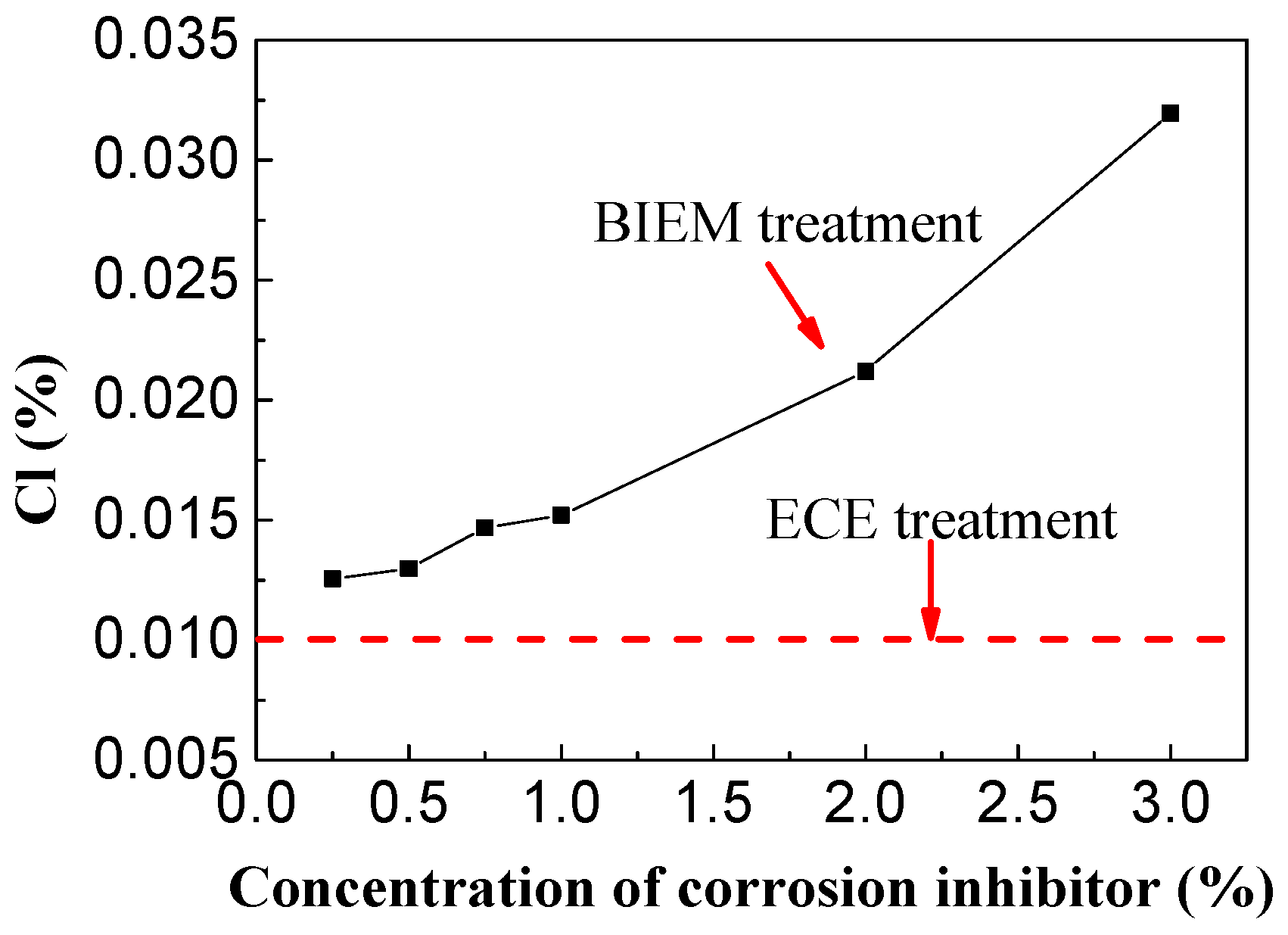
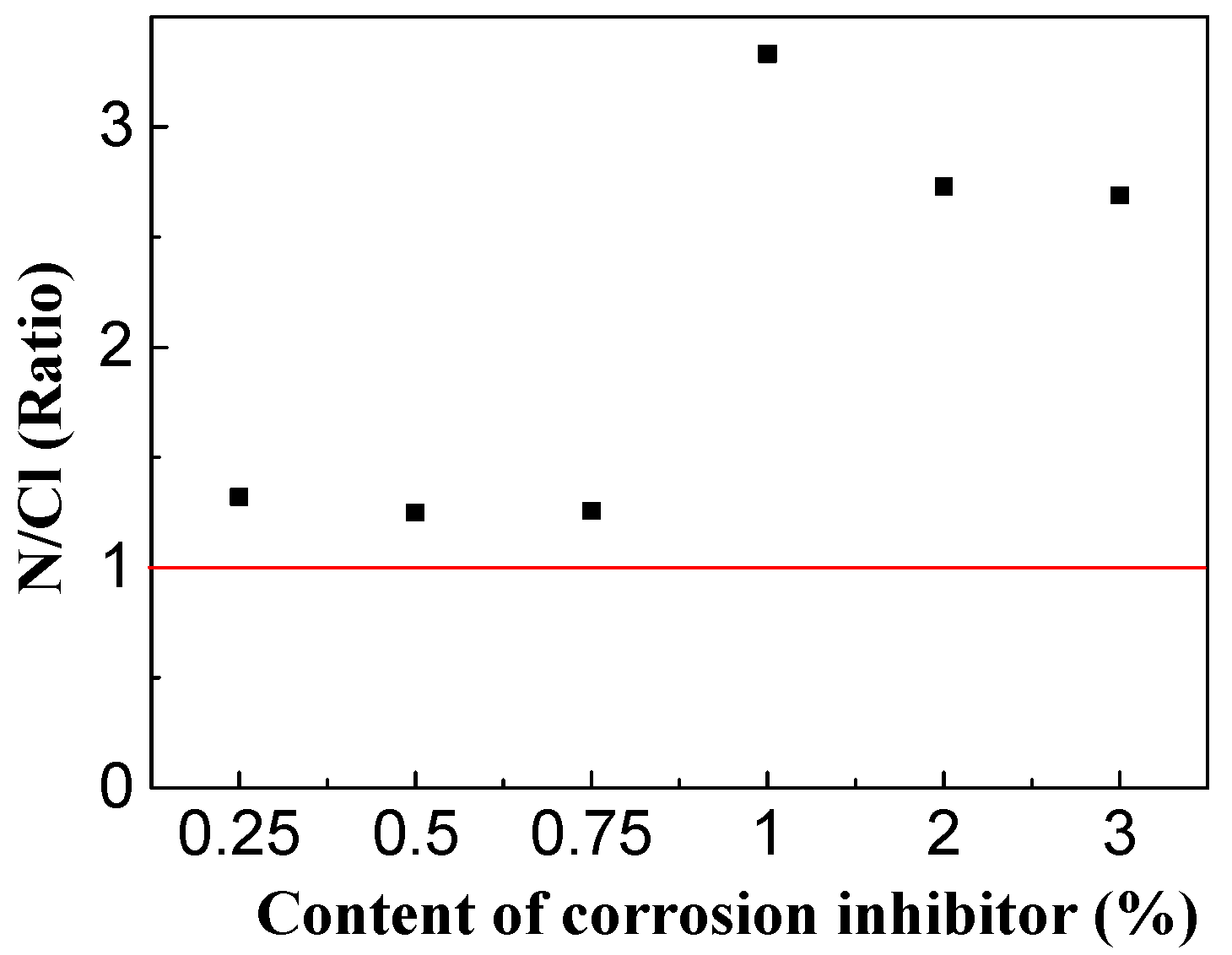
| Strength Grade | W/C | Cement Mark | Water (kg/m3) | Cement (kg/m3) | Sand (kg/m3) | Gravel (kg/m3) |
|---|---|---|---|---|---|---|
| C35 | 0.48 | 42.5 | 220 | 457.6 | 577.6 | 1072.6 |
| Type of Inhibitor | Contents (%) | Corrosion Potential(mV) |
|---|---|---|
| Triethylenetetramine | 0.25 | −340~−320 |
| 0.5 | −320~−300 | |
| 0.75 | −290~−270 | |
| 1 | −290~−250 | |
| 2 | −280~−270 | |
| 3 | −260~−240 | |
| Imidazoline | 0.25 | −280~−260 |
| 0.5 | −250~−240 | |
| 0.75 | −240~−230 | |
| 1 | −230~−210 | |
| 2 | −240~−220 | |
| 3 | −200~−180 | |
| Ca(OH)2 | −360~−340 |
© 2020 by the authors. Licensee MDPI, Basel, Switzerland. This article is an open access article distributed under the terms and conditions of the Creative Commons Attribution (CC BY) license (http://creativecommons.org/licenses/by/4.0/).
Share and Cite
Pan, C.; Li, X.; Mao, J. The Effect of a Corrosion Inhibitor on the Rehabilitation of Reinforced Concrete Containing Sea Sand and Seawater. Materials 2020, 13, 1480. https://doi.org/10.3390/ma13061480
Pan C, Li X, Mao J. The Effect of a Corrosion Inhibitor on the Rehabilitation of Reinforced Concrete Containing Sea Sand and Seawater. Materials. 2020; 13(6):1480. https://doi.org/10.3390/ma13061480
Chicago/Turabian StylePan, Chonggen, Xu Li, and Jianghong Mao. 2020. "The Effect of a Corrosion Inhibitor on the Rehabilitation of Reinforced Concrete Containing Sea Sand and Seawater" Materials 13, no. 6: 1480. https://doi.org/10.3390/ma13061480
APA StylePan, C., Li, X., & Mao, J. (2020). The Effect of a Corrosion Inhibitor on the Rehabilitation of Reinforced Concrete Containing Sea Sand and Seawater. Materials, 13(6), 1480. https://doi.org/10.3390/ma13061480




